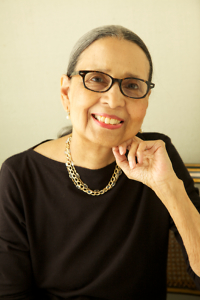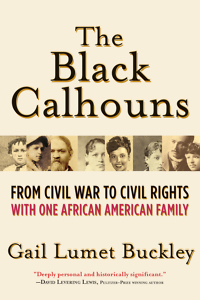The Black Calhouns: From Civil War to Civil Rights with One African American Family is more than the biography of entertainment trailblazer and civil-rights icon Lena Horne. Gail Lumet Buckley, Horne’s daughter, traces the lives of her ancestors from emancipation to present-day America, fleshing out a cast of achievers, dreamers, and do-ers that contextualize the Lena Horne we know. Beginning with Buckley’s great-great-grandfather Moses Calhoun, a newly freed Atlanta man in 1865, the family members act as touchstones for a history of the struggle for black liberation. It is certainly not the history, as Buckley is quick to point out: her middle-class family was always somewhat protected from the worst of Southern racism. Nonetheless, this engrossing, memorable account lays out a too-often glossed-over and anesthetized African-American history that may send readers on a mission to learn more.

The Black Calhouns is as much a book about division as it is about collective power. Moses Calhoun was a favored slave: because his owner (and likely father) wanted a butler who was somewhat sophisticated, Moses learned to read and write. This fact—and his good standing within his owner’s affluent community—allowed him to land quite comfortably in 1865, while many other freed blacks found themselves poor and resourceless. Moses represented the promise of Reconstruction come true: he opened two businesses, married, and fathered two daughters, Cora and the first Lena, who attended the first school for blacks led by Northern missionary teachers. Moses’s daughters would attend college. They were the Talented Tenth, the generation of highly educated, freeborn black youth who would, as W.E.B. Du Bois wrote, “be made leaders of thought and missionaries of culture among their people.”
Woven through this chapter of the Calhoun clan’s history are the words and writings of eminent intellectuals like Du Bois, Frederick Douglass, and Booker T. Washington. Buckley illuminates their often-conflicting ideologies, showing the competing schools of thought around racial equality. She folds in original writings, letters, and first-person accounts of the U.S. government’s reversals on the promises it made with the Thirteenth, Fourteenth, and Fifteenth Amendments. At the same time, Buckley charts the beginning of the NAACP and Urban League, the institutions of black resistance to the racism of the South, which was fierce and deadly, and of the North, which was quieter but ingrained in its every institution.
 If there is one other Calhoun who stands out almost as much as Lena Horne, it is undoubtedly her grandmother Cora. After marrying Edwin Horne, an Indiana Republican and editor of a black newspaper, Cora moved to New York with her growing family. As Buckley writes, Northern blacks were not necessarily happier than their Southern counterparts. Though the Hornes moved into a world of greater choices and resources, family members who remained in the South had community, the church, and the central, unshakable entity of the family. Cora Horne got busy raising her children, and she threw herself into civic work that would fill the void when her relationship with Edwin fell apart. She held offices in civic organizations and operated from her position to lift up others. She was also stubborn and often elitist—a mark of the Talented Tenth—but unshakable in her commitment to help better the conditions of black Americans.
If there is one other Calhoun who stands out almost as much as Lena Horne, it is undoubtedly her grandmother Cora. After marrying Edwin Horne, an Indiana Republican and editor of a black newspaper, Cora moved to New York with her growing family. As Buckley writes, Northern blacks were not necessarily happier than their Southern counterparts. Though the Hornes moved into a world of greater choices and resources, family members who remained in the South had community, the church, and the central, unshakable entity of the family. Cora Horne got busy raising her children, and she threw herself into civic work that would fill the void when her relationship with Edwin fell apart. She held offices in civic organizations and operated from her position to lift up others. She was also stubborn and often elitist—a mark of the Talented Tenth—but unshakable in her commitment to help better the conditions of black Americans.
Lena Horne doesn’t make an appearance until the second half of this book, but Buckley weaves such a rich tapestry that Lena’s predecessors are just as real and engrossing as the star we know. Her grandfather Edwin, though disloyal to Cora, spent his time in Manhattan as a Tammany man and witnessed the Harlem Renaissance. Edwin’s story bears out the conflicts within both the Democratic and Republican parties over race—as each courted and betrayed black Americans, Edwin switched parties and alliances. He also loved the theater and took young Lena to the Cotton Club. Lena’s uncle Frank Horne was a poet and teacher; he later served in FDR’s “Black Cabinet.”
Buckley follows Lena through her first years on stage, her break into Hollywood, her illustrious nightclub career, and her inner turmoil regarding tokenization—the pressure to be one of the “respectable” black entertainers worthy of mainstream attention, but also the discomfort and shame she felt as a result of her privilege. As she got older, Horne became radicalized. Her visits to military bases showed her the racist treatment of black G.I.s. Buckley writes, “The surest way for a young black man to learn that he was a Negro in America was to join the U.S. Army and to hear the N-word, and every other form of insult, every single day of his military life.” Of her mother, Buckley writes,
She did not live like a Negro, and she did not think like a Negro. But her skin was still black and she still faced the discrimination that all blacks felt—except on a different scale. She felt she had been a good little symbol, but nothing had changed; in the South, blacks still could not vote and their children could not get a decent education.
As Lena Horne’s call to activism solidified, she slowly became an icon of the Movement. Meanwhile, Buckley herself got a job at the National Scholarship Fund for Negro Students and then a position at Life magazine, where racial prejudice was minimal, but where misogyny thrived. “Since my feminist consciousness was in the cellar, I did not speak out,” she writes. “Strong women were not generally admired by either men or women.”
Transitioning back and forth between the Northern family and the Southern, this captivating history brings six generations of black Americans alive. Readers who need to brush up on African-American history or extend their understanding past the handful of figures allotted space in our history books will find an excellent jumping-off point in The Black Calhouns. Buckley’s own children, grandchildren, and great-grandchildren are also Black Calhouns, and their mark on the world may call for a sequel.
If we learn anything from The Black Calhouns, it is that those operating from a place of privilege—be it racial or economic—have a responsibility to lift up those below them. That is the legacy of Cora Calhoun Horne, Lena Horne, and Gail Lumet Buckley.

Erica Ciccarone is an independent writer living in Nashville. She holds an M.F.A. from the New School and contributes regularly to several print and online publications and to Nashville Public Radio. .





